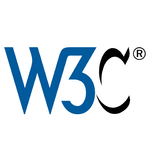W3C
| Type: | Non-Profit Corporation |
| Industry: | Web Technologies |
| Founded: | 1994 |
| Headquarters: | World Wide Web Consortium, Inc. 401 Edgewater Place, Suite 600 Wakefield, MA 01880 USA |
| Country: | USA, Europe, Japan, China |
| Businesses: | Web standardization |
| Products: | Web Standards and Tools |
| Employees: | <100 |
| Revenue: | ~10M$ = expenses |
| Website: | w3.org |
| LinkedIn: | W3C on LinkedIn |
| Twitter: | |
| Key People | |
| Tim Berners-Lee, Founder, Emeritus Director
Seth Dobbs, President & CEO Ralph Swick, COO Coralie Mercier, Head of Communications | |
The World Wide Web Consortium (W3C) is an international public-interest non-profit organization where web standards are developed by a hired staff that works together with member organizations and the public, to ensure the long-term growth of the Web, and to work for the benefit of humanity. [1]
Overview[edit | edit source]
W3C was founded in 1994 by Tim Berners-Lee. Its mission is to bring together international stakeholders to develop open standards for an interoperable web to meet requirements for accessibility, internationalization, privacy, and security – for technologies which connect and empower humanity. W3C facilitates participation, involvement, sharing of knowledge, and building trust at a global level. It enjoys the support of many important industries and organizations. See the W3C current Members.
W3C Standards[edit | edit source]
First started as an IETF application area at the beginning of 1990, the Web standard stack, given its foreseen volume and applicative nature on top of the Internet protocols, quickly spun off its own forum. W3C then laid the foundations of the Web with the development of HTML 4 and XML at the end of the last century. It still works closely with IETF today, on the HTTP or URL specifications and in other areas of common interest (e.g., crypto, security, video).
Other well-known technologies developed by W3C include the WAI/WCAG guidelines for people with disabilities (largely adopted by governments and an ISO standard as well), CSS, WebRTC, WebFonts, SVG, the Web Services stack or the Semantic Web/Linked Data activities, only to name a few.
Since its creation, W3C has developed more than 500 Web Standards, which they refer to as "Recommendations." Each recommendation was developed by working groups that consist of W3C members engineers and invited experts from the public who have experience in the applicable field.
A recommendation is steered by a Working Group, and must pass through several steps (also called maturity levels):
- Typically a series of Working Drafts are published, accessible to all, each of which refines a document under development
- Once review suggests the Working Group has met their requirements satisfactorily for a new standard, there is a Candidate Recommendation phase. This allows the W3C membership to provide feedback on whether the specification is appropriate as a W3C Recommendation, while the Working Group formally collects implementation experience to demonstrate that the specification works in practice.
- The next phase is a Proposed Recommendation, to finalize the review of W3C Members. When W3C Member review supports a specification becoming a standard, W3C publishes it as a Recommendation.
W3C Organization[edit | edit source]
W3C is incorporated in the USA as a public-interest non-profit 501(c)(3) organization since January 2023. [2]
For the first 28 years of its operation, W3C was administered via a joint agreement among four "Host Institutions": MIT (USA), ERCIM (France/EU), Keio University (Japan), and Beihang University (China).
The W3C staff (most of whom work remotely across 11 different countries) is led by President & CEO Seth Dobbs and a Board of Directors. Founding Director Tim Berners-Lee acts as a non-voting Board Director.
In process terms: the W3C Process Document and a few other documents establish the roles and responsibilities of the parties involved in the making of W3C standards. Some key components of the organization are:
- the Advisory Committee, composed of one representative from each W3C Member
- the Advisory Board (AB), an advisory body elected by the Advisory Committee
- the Technical Architecture Group (TAG), primarily responsible for Web Architecture choices
- the W3C CEO, who assess consensus for W3C-wide decisions
- the chartered groups, populated by Member representatives and invited experts, and which produce most of W3C's deliverables according to the steps of the W3C Process.
As of 2024, W3C had 360 members [3] from various sectors and world regions. In order to be accessible to a wide range of international organizations, W3C offers membership fees on a sliding scale dependent on annual revenue, type of business, and the location of the organization's headquarters.[4]
W3C is in liaisons with most of the other SDOs (Standard Development Organizations) dealing with Digital technologies, to ensure that there is a coherent set of standards to maximize the end-user experience of its Open Web Platform.
